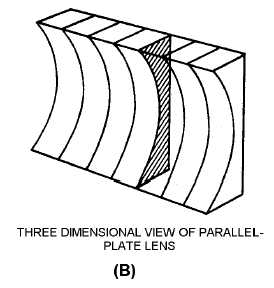3-11
Figure 3-10B.—Waveguide lens.
The radiated energy consists of an infinite number of RADIAL SECTIONS (RAYS). Each of the
radial sections contains mutually perpendicular E and H lines and both are perpendicular to the direction
of travel. Because each of the radial sections travels in a different direction, the point source, in itself, has
poor directivity. The purpose of the lens is to convert the input spherical microwave segment (which
consists of all of the radial sections) into parallel (collimated) lines in a given direction at the exit side of
the lens. The focusing action of the lens is accomplished by the refracting qualities of the metallic strips.
The collimating effect of the lens is possible because the velocity of electromagnetic energy propagation
through metals is greater than its velocity through air. Because of the concave construction of the lens,
wavefronts arriving near the ends of the lens travel farther in the same amount of time than do those at the
center. Thus, the wavefront emerging from the exit side of the lens appears as a plane wave. It consists of
an infinite number of parallel sections (with both the E field and H field components) mutually
perpendicular to the direction of travel.
Delay lens
Another type of lens that you may see is the DIELECTRIC or METALLIC DELAY LENS shown in
figure 3-11. The delay lens, as its name implies, slows down the phase propagation (velocity) as the wave
passes through the lens. The delay lens is convex and is constructed of dielectric material. The delay in
the phase of the wave passing through the lens is determined by the DIELECTRIC CONSTANT
(REFRACTIVE INDEX) of the material. In most cases, artificial dielectrics, consisting of conducting
rods or spheres that are small compared to the wavelength, are used. (Artificial dielectrics are of
three-dimensional construction and act as a dielectric to electromagnetic waves.) In this case the inner
portion of the transmitted wave is decelerated for a longer interval of time than the outer portions. The
delay causes the radiated wave to be collimated.

